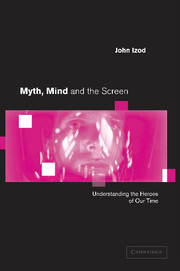Book contents
- Frontmatter
- Contents
- Acknowledgments
- Introduction
- 1 Jungian theory, textual analysis and audience play
- 2 Archetypal images: signification and the psyche
- 3 Archetypal images: symbols and the cultural unconscious
- 4 The Piano, the animus and colonial experience
- 5 The pop star as icon
- 6 The quest of a female hero: The Silence of the Lambs
- 7 Television sport and the sacrificial hero
- 8 The polycentred self: The Passion of Darkly Noon
- 9 Haunted: searching for the whole self
- 10 Transforming the final ghost: the god within
- Conclusion
- Filmography
- Glossary of Jungian and related terms
- References
- Index
9 - Haunted: searching for the whole self
Published online by Cambridge University Press: 22 September 2009
- Frontmatter
- Contents
- Acknowledgments
- Introduction
- 1 Jungian theory, textual analysis and audience play
- 2 Archetypal images: signification and the psyche
- 3 Archetypal images: symbols and the cultural unconscious
- 4 The Piano, the animus and colonial experience
- 5 The pop star as icon
- 6 The quest of a female hero: The Silence of the Lambs
- 7 Television sport and the sacrificial hero
- 8 The polycentred self: The Passion of Darkly Noon
- 9 Haunted: searching for the whole self
- 10 Transforming the final ghost: the god within
- Conclusion
- Filmography
- Glossary of Jungian and related terms
- References
- Index
Summary
In the 1990s, British and North American audiences were once again being invaded by a wave of phantoms and aliens. Some of them travelled in on the Ultra High Frequency wave band. Others, like their predecessors in the 1950s and 1970s, came in on beams of light.
From the perspective of analytical psychology, ghosts can be seen as representations of half-formed impressions generated in or released after suppression from the unconscious. It hardly needs adding that they are often regarded as hostile and the cause of deep distress. But one of the interesting features of the 1990s invasion was that a high proportion of the visitors were more or less friendly.
Take, for example, a series transmitted in 1996 on the mainline commercial channel in the UK under the title Strange But True. This found its material in the reconstruction of all manner of strange encounters. It could be described as reality programming focusing on the occult world. As such it shared with other reality programming (such as documentary) a marked tendency to favour tabloid journalism – the kind of thing previously located in programmes about the activities of the emergency services – such as the BBC's 999 and CBS's Rescue 911. The reality TV format imported several features into Strange but True: reconstructions, eye-witness accounts to verify extraordinary events and the rhetoric of immediacy, with the whole thing being played at a crisp pace.
- Type
- Chapter
- Information
- Myth, Mind and the ScreenUnderstanding the Heroes of our Time, pp. 160 - 184Publisher: Cambridge University PressPrint publication year: 2001



